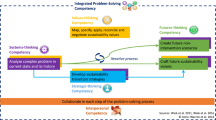Abstract
Introduction
A health disparities curriculum that uses evidence-based knowledge rooted in pedagogic theory is needed to educate health care providers to meet the needs of an increasingly diverse U.S. population.
Description
The Health Disparities Education: Beyond Cultural Competency Precourse, along with its accompanying Train the Trainer Guide: Health Disparities Education (2008), developed by the Society of General Internal Medicine (SGIM) Disparities Task Force (DTF), is a comprehensive tool to facilitate developing, implementing and evaluating health disparities education. The curriculum includes five modules highlighting several fundamental concepts in health disparities, suggestions for teaching about health disparities in a wide range of settings and strategies for curriculum evaluation. The modules are Disparities Foundations, Teaching Disparities in the Clinical Setting, Disparities Beyond the Clinical Setting, Teaching about Disparities Through Community Involvement, and Curriculum Evaluation.
Evaluation
All five modules were delivered as a precourse at the 31st Annual SGIM Annual Meeting in Pittsburgh, PA and received the “Best Precourse Award”. This award is given to the most highly rated precourse based on participant evaluations. The modules have also been adapted into a web-based guide that has been downloaded at least 59 times.
Conclusion
Ultimately, the modules are designed to develop a professional commitment to eliminating racial and ethnic disparities in health care quality, promote an understanding of the role of health care providers in reducing health care disparities through comprehensive education and training, and provide a framework with which providers can address the causes of disparities in various educational settings.
Similar content being viewed by others
References
Smedley BD, Stith AY, Nelson AR. Unequal treatment. Confronting racial and ethnic disparities in health care. Washington, DC: Institute of Medicine of the National Academies; 2002.
Hobson W, Avant-Mier R, Cochella S, et al. Caring for the underserved: using patient and physican focus grops to inform curriculum development. Ambul Pediatr. 2005;5:90–95.
Jacobs E, Kohrman C, Lemon M, Vickers D. Teaching physicians-in-training to address racial disparities in health: a hospital-community partnership. Public Health Rep. 2003;118:349–56.
Vela M, Kim K, Tang H, Chin M. Innovative health care disparities curriculum for incoming medical students. JGIM. 2008;7:1028–32.
Ko M, Heslin K, Edelstein R. The role of medical education in reducing health care disparities: the first ten years of the UCLA/Drew medical education program. J Gen Intern Med. 2007;22:625–31.
Beach M, Prince E, Gary T, et al. Cultural copetence: a systematic review of health care provider educational interventions. Med Care. 2005;43:356–73.
Kumagai AK, Lypson ML. Beyond cultural competence: critical consciousness, social justice and multicual education. Acad Med. 2009;84(6):782–87.
Trevalon M, Murray-Garcia J. Cultural humility versus cultural competence: a critical distinction in defining physican training outcomes in multicultural education. J Health Care Poor Underserved. 1998;9:117–25.
D’Eon MF, AuYeung D. Follow-up in train-the-trainer continuing medical education events. J Contin Educ Health Prof. 2001;21:33–39.
Orfaly RA, Frances JC, Campbell P, Whittemore B, Joly B, Koh H. Train-the-trainer as an educational model in public health preparedness. J Public Health Manag Pract. 2005;11(6):S123–S27.
Brukner H, Altkorn D, Cook S, Quinn M, McNabb W. Giving effective feedback to medical studnets: a workshop for faculty and house staff. Med Teach. 1999;21(2):161–65.
Branch W, Frankel R, Gracey C, et al. A good clinician and a caring person: Longitudinal faculty development and the enhancement of the human dimensions of care. Acad Med. 2009;84(1):117–25.
Smith WR, Betancourt JR, Wynia MK, et al. Recommendations for teaching about racial and ethnic disparities in health and health care. Ann Intern Med. 2007;147:654–65.
Graffam B. Active learning in medical education: strategies for beginning implementation. Med Teach. 2007;29(1):38–42.
Kumagai AK. A conceptual framework for use of illness narratives in medical education. Acad Med. 2008;83(7):653–58.
Acknowledgements
Funding for the initial phases of this work was provided by the Society of General Internal Medicine (SGIM) Council. Dr. C. Cené is supported through the UNC Clinical Translational Science Award-K12 Scholars Program (1KL2RR025746-01). Dr. A. Fernández is supported by the Arnold P. Gold Foundation. Dr. M. Peek is supported through the Robert Wood Johnson Foundation Harold Amos Medical Faculty Development Program and National Institute of Diabetes and Digestive and Kidney Diseases (K23DK075006-04).
Author information
Authors and Affiliations
Corresponding author
Additional information
On Behalf of the Society of General Internal Medicine Disparities Task Force
Dr. C. Cené is supported through the UNC Clinical Translational Science Award-K12 Scholars Program (1KL2RR025746-01).
Dr. A. Fernández is supported by the Arnold P. Gold Foundation.
Dr. M. Peek is supported through the Robert Wood Johnson Foundation Harold Amos Medical Faculty Development Program and National Institute of Diabetes and Digestive and Kidney Diseases (K23DK075006-04).
Dr. A. Brown received support from the UCLA Resource Center in Minority Aging Research (#AG02004), the National Center on Minority Health and Health Disparities (#P20MD00148), and the National Heart Lung and Blood Institute (# NL079240).
Dr. C. Horowitz received support from the National Center on Minority Health and Health Disparities (R24 MD001691), the National Center for Research Resources (UL1RR029887) and the Centers for Disease Control and Prevention REACH-US (U58DP001010).
Dr. S. Glick is supported by the National Heart, Lung and Blood Institute (K07HL081429).
Rights and permissions
About this article
Cite this article
Ross, P.T., Wiley Cené, C., Bussey-Jones, J. et al. A Strategy for Improving Health Disparities Education in Medicine. J GEN INTERN MED 25 (Suppl 2), 160–163 (2010). https://doi.org/10.1007/s11606-010-1283-3
Published:
Issue Date:
DOI: https://doi.org/10.1007/s11606-010-1283-3




